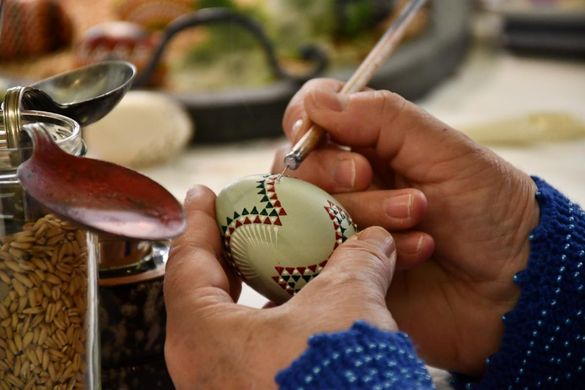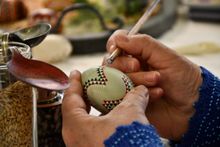 09 Aug 2025
09 Aug 2025

By the end of winter everybody is yearning for warmertemperatures. Trees begin to flower, new leaves grow- and Easter is just around the corner.Easter is celebrated in Saxony with different festivities – some steeped in tradition, others basedmore on welcoming the start of spring and renewal. Saxony truly offers something for everyone:from idyllic excursions into the countryside to regional delicacies and traditional customs.
In Upper Lusatia, located in the east of Saxony, you can find ancient Easter customs, which arestill actively celebrated among the Sorbs, a slavic minority from this region. For Slavic tribes likethe Sorbs, the gifting of elaborately decorated eggs actually goes back to pagan times. In manycultures, eggs are a symbol of fertility and were eventually integrated into religion as a symbol forthe resurrection of Jesus.
Traditionally the Sorbs decorate their Easter eggs on Good Friday using various techniques suchas the so-called waxing and etching techniques. Now however, the Easter markets take placebefore Good Friday so many people have the chance to see the craftspeople at work and to buysome eggs to take home.
At the Sorbian Easter Egg Market in Schleife, almost 30 Easter egg paintersfrom Lusatia in eastern Saxony allow you to look over their shoulders as they decorate theirdelicate works of art at the Sorbian Cultural Center. The artists love questions and interestingconversations with visitors and, of course, offer their works for sale. All four techniques of Easteregg decorating that are common in Lusatia are represented: wax batik and wax embossingtechniques, as well as scratching and the now rare etching technique.
Colorful market stalls with handicrafts, agricultural products as well as Easter gifts made ofceramics, glass, felt, wool, fabric or wood and a Sorbian program delight visitors. Regionallyproduced delicacies such as cooked cheese, egg pancakes, smoked fish, Easter bread, breadsausage, lard sandwiches and crumb cakes are satisfying and filling. The Schleife poultrybreeders' association will fill the incubator with eggs three weeks before the market so that thechicks can be watched hatching in time for the Easter egg market. Anyone who would like todecorate Sorbian Easter eggs themselves using the wax batik technique, can try this out underexpert guidance in the "egg painting workshop.”
The larger cities of Dresden and Leipzig also celebrate the start of spring and the coming ofEaster. The DRESDEN EASTER is said to be one of the city's most popular public fairs.Traditionally the city invites visitors to the "start into spring" shortly before Easter. The the city celebrates Easter with the International Orchid World, one of thelargest and most important orchid shows in Europe, where visitors can experience a magicaldisplay of thousands of flowers, impressively and adventurously arranged.
The Easter market in Dresden and the Historical Leipzig Easter Fair will attract visitors to the city center. Jugglers, comedians and musicians viefor attention while food stalls with hearty dishes and taverns full of refreshing drinks invite you totoast the coming of spring. Very special is the chance to experience the music of Easter inLeipzig. With tickets, you can experience the St. Thomas Choir of Leipzig together with the Gewandhausorchester in St. Thomas Church and performances of Johann Sebastian Bach's St.John Passion.
There is the annual Sorbian Easter egg market in Bautzen. Visitors watch the folk artists turn the chicken egg into a small work of art by using the traditional techniques of waxing, embossing, scratching and etching. Colorful Sorbian Easter eggs, which have long been a gift from godparents alongside Easter rolls and gingerbread, have retainedtheir original magic to this day. You can come and visit and even decorate an eggyourself. You can also learn interesting facts about the history and culture of the Sorbs at theSorbian cultural information center. Children can paint "their" Easter egg themselves with supervision.


